Monthly economic brief: June 2020
Provides a summary of latest key economic statistics, forecasts and analysis on the Scottish economy.
This document is part of a collection
Output
Scotland's economic activity has been significantly impacted by the coronavirus pandemic and the introduction of lockdown measures both domestically and internationally. Latest GDP estimates for Scotland are for Q4 2019 and so are prior to the outbreak of the pandemic. GDP for Q1 2020, and monthly GDP for April, will be published on 17 June. First estimates of UK GDP for Q1 2020 provide insight into the impacts on UK output as the coronavirus spread across continents and UK physical distancing guidance and lockdown measures introduced in March.
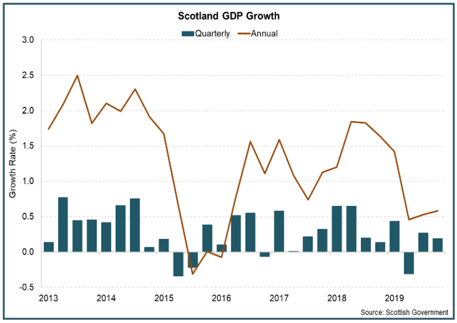
- Scottish GDP (second estimate) grew by 0.2% in Q4 2019, down from 0.3% in Q3 2019.
- UK GDP (first estimate) contracted by 2.0% in Q1 2020, its largest contraction since 2008.
- The fall in UK GDP in Q1 was driven by a 5.8% contraction in March with broad based falls in output across Services (-6.2%), Production (‑4.2%) and Construction (-5.9%) sectors.
| Quarterly GDP Growth (%) | Q1 2019 | Q2 2019 | Q3 2019 | Q4 2019 | Q1 2020 |
|---|---|---|---|---|---|
| Scotland | 0.4 | -0.3 | 0.3 | 0.2 | - |
| UK | 0.7 | -0.2 | 0.5 | 0.0 | -2.0 |
The coronavirus pandemic has resulted in a global economic crisis with significant impacts on the GDP of Scotland's key trading partners.
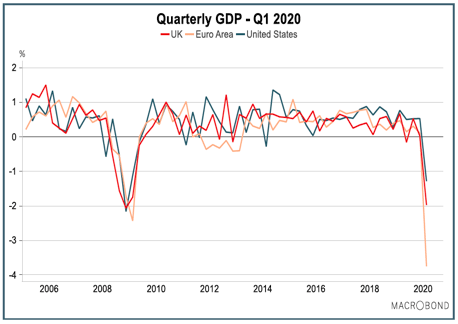
- Euro Area GDP contracted by 3.8% in Q1 2020 (-3.2% annually), its sharpest contraction since the series started in 1995.
- US GDP contracted by 1.2% in Q1 2020, its sharpest contraction since the financial crisis.
Medium Term Outlook
Since the economic update in the State of the Economy in April, the Scottish Government's route map through and out of the coronavirus crisis has been published providing an indication of the order in which current restrictions will be carefully and gradually lifted.
As the economy restarts, not all sectors will come back immediately as external demand, consumer tastes, and business models will have changed.
Although some of these changes may be temporary or could begin to reverse over time, it seems increasingly likely that there could be some permanent structural changes to the economy, which may reduce productive capacity in the economy in the short term and our updated analysis explores this.
Updated Modelling
The modelling presents two illustrative scenarios for the economy, not forecasts or predictions, but scenarios that reflect key policy variables and potential recovery paths for the economy.
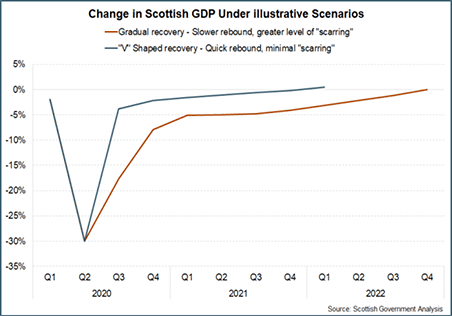
In the first scenario, "V-shaped Recovery", there is a swift recovery across all sectors, with minimal loss of productive capacity or scarring on the economy. In the second scenario, "Gradual Recovery", a greater degree of scarring is assumed and sectors recover at different speeds as restrictions are gradually lifted.
Despite both scenarios having the same profile up to 2020 Q2, the medium term pathway looks very different. In the 'Gradual Recovery' scenario, the slower rebound in demand causes the short-term downturn to be more protracted, and more importantly the greater degree of scarring means economic output does not recovery to pre-crisis levels until the start of 2023.
Labour Market Uncertainty
Furlough Schemes and Official Labour Market Data
As of 31 May there are 8.7 million furloughed jobs in the UK,[2] representing around a quarter of the labour force. It remains uncertain how many furloughed workers may eventually become unemployed as the scheme unwinds.
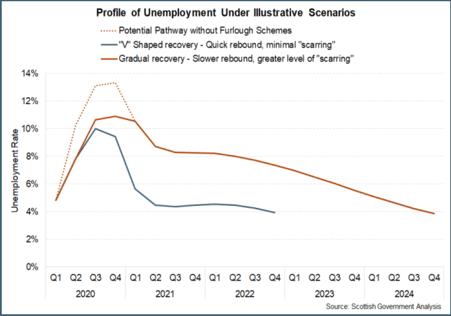
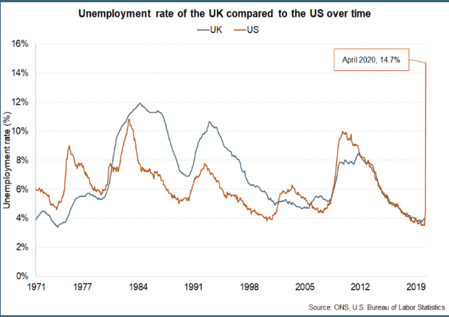
The adjacent chart illustrates the impact the Job Retention Scheme could have on headline unemployment rates in Scotland. Even with the current levels of government fiscal support, in the absence of the scheme, it is estimated that unemployment could have reached around 14%. This is similar to what has already been seen in the US, where there is no equivalent scheme. Ultimately, the level of unemployment will depend on how many people currently furloughed become unemployed as the scheme is unwound. This highlights the importance of withdrawing the scheme gradually.
Medium term labour market recovery
There is still a significant amount of uncertainty over how the labour market may recover. For example, during the financial crisis, there was evidence of employees willing to accept pay cuts in order to maintain employment. Alternatively, firms may prefer to maintain wages to retain experienced staff in the short-term, whilst keeping fewer staff to cut costs. The impact of previous recessions on the labour market is discussed later in the report.
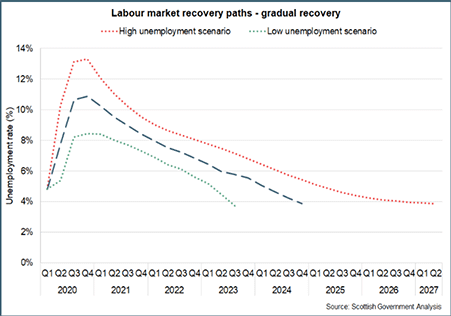
To illustrate how the labour market may recover under the "Gradual Recovery" scenario, sensitivity analysis has been undertaken around the impact of the policy response and the speed of the labour market recovery. Depending on how the recovery progresses, unemployment could take between 3 to 6 years to recover to pre-crisis levels.
Contact
Email: OCEABusiness@gov.scot
There is a problem
Thanks for your feedback